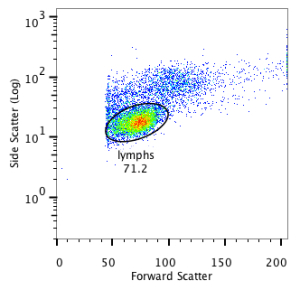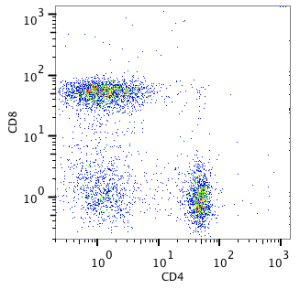Analog instruments such as BD FACSCalibur and BD FACScan produce FCS2.0 files.
Analog data (or FCS2.0) data files are read by FlowJo in the format they were exported. Analog data files are exported with data scaling information and compensated fluorescence values (if compensation was done on the instrument). Therefore, all FCS2.0 data read into FlowJo will appear exactly* the same as it did on the acquisition instrument. As the software cannot manipulate FCS2.0 data due to the stringent analog standard keyword convention, little can be done to rescale or adjust the data once it is acquired.
Below is an example of data scaled with a range typical of FCS2.0 data (a range of 1024 and 4 decades of log space):


*Some digital instruments produce LMD files (a FCS2.0 and FCS3.0 file combined) or can export as FCS2.0 files. The cytometer may acquire with an FCS3.0 data appearence, but when exported, write the file as 2.0. In these cases, it may be necessary to change the preferences in FlowJo to read the FCS2.0 or FCS3.0 portion (if an LMD file) or to go back to the machine and export the data again (if exported as FCS2.0 by accident).
This data standard is not ideal as compared to FCS3.0/FCS3.1 data for three main reasons:
1. The dynamic range is only set at 1024 total channels, providing less room for resolving positive and negative populations, particularly when expression is low or ‘dim’.
Problem 1 cannot be solved by FlowJo or any other software package. The dynamic range IS the dynamic range, so it cannot be edited post-acquisition. However, a 1024 range is suitable for many applications.
2. This data standard was created before the invention of instruments capable of producing compensation matrices with the acquisition software. Therefore, FCS2.0 files do not include a keyword for the compensation matrix. Any compensation done on an analog instrument is done with the hardware. Compensated data is the data recorded into the file, so the raw data is lost. Therefore, if you overcompensate, there is no recourse.
Problem 2 can be solved by using FlowJo’s software compensation. Simply record the data uncompensated or undercompensated and use FlowJo to finish the compensation. This way, you don’t have to worry about overcompensating.
3. Data is log converted with a piece of hardware called the “log-amp convertor”. Therefore, raw linear data cannot be used to produce an accurate biexponential transform. Biexponentially transforming FCS2.0 data is very difficult and often produces display artifacts.
Problem 3 also cannot be easily dealt with in FlowJo unless all data is recorded in linear, and log (or biexponentially) transformed in FlowJo.
